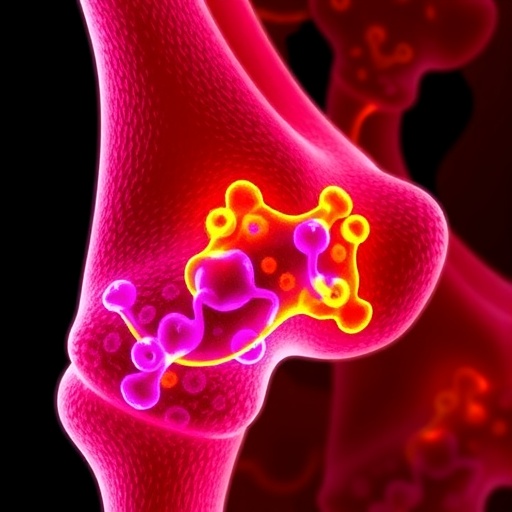In a groundbreaking study, researchers have developed an innovative method for accelerating cartilage regeneration through a sophisticated system that leverages the unique properties of DNA silk fibroin hydrogels. This pivotal research, conducted by Shen and colleagues, represents a significant advancement in the field of regenerative medicine, particularly for conditions involving cartilage damage, which is a prevalent issue in both civilian healthcare and military settings. The utilization of cartilage organoids encapsulated within a DNA-based hydrogel offers promising therapeutic potential for enhancing tissue repair and regeneration.
Cartilage damage often leads to debilitating joint conditions, resulting in pain and loss of function for millions of individuals globally. Traditional treatment options, including surgical interventions and stem cell therapies, can be limited by several factors, such as the availability of graft material and the body’s inherent healing capabilities. The introduction of a DNA-silk fibroin hydrogel aims to overcome these limitations by providing a supportive environment that encourages the proliferation and differentiation of chondrocytes, the cells responsible for cartilage formation. This study highlights how the integration of bioengineering and regenerative medicine can pave the way for novel treatment modalities.
The DNA-silk fibroin hydrogel utilized in this research is particularly noteworthy due to its ability to create a controlled release system for growth factors and other bioactive molecules. By encapsulating cartilage organoids within this hydrogel, researchers can sustain the delivery of necessary nutrients and signals to the cells, mimicking the natural extracellular matrix found in healthy cartilage. This sustained release mechanism is crucial, as it helps maintain an optimal microenvironment that is conducive to cell survival and function.
One of the primary benefits of this innovative approach is the potential to significantly enhance cartilage regeneration in patients suffering from osteoarthritis or other degenerative joint conditions. By providing a scaffold that not only supports cell growth but also actively participates in signaling pathways necessary for tissue regeneration, the DNA-silk fibroin hydrogel could represent a paradigm shift in how cartilage-related injuries are treated. The research team is optimistic that this technology could lead to improved outcomes and quality of life for affected individuals, bridging the gap between advanced scientific research and clinical application.
Moreover, the study underscores the importance of collaborative efforts in scientific research. The team, which includes experts from various fields, such as material science, molecular biology, and clinical medicine, has worked diligently to optimize the formulation and delivery of the hydrogel system. This interdisciplinary approach is essential, as it combines diverse expertise to address a complex medical challenge. By integrating insights from multiple domains, the researchers have managed to create a cutting-edge solution that has the potential to revolutionize cartilage repair strategies.
The researchers conducted a series of preclinical trials to assess the efficacy of the DNA-silk fibroin hydrogel in promoting cartilage regeneration. These trials involved implanting the hydrogel-loaded cartilage organoids into animal models with induced cartilage defects. The results were promising, showing a marked improvement in cartilage tissue structure and function compared to controls that received no treatment or conventional therapies. Histological analyses revealed increased cartilage thickness and enhanced biomechanical properties, supporting the hydrogel’s role in tissue repair.
An essential aspect of this research lies in its translational potential. The team is aware of the challenges faced in moving experimental therapies from the lab to clinical settings, including regulatory hurdles and patient safety considerations. Therefore, they have incorporated rigorous testing protocols that adhere to ethical guidelines, ensuring that the hydrogel system is not only effective but also safe for human use. Initial feedback from regulatory bodies has been optimistic, indicating a forward path for eventual clinical trials.
The implications of this research extend beyond just cartilage repair; the principles underlying the DNA-silk fibroin hydrogel system could be adapted for other applications in tissue engineering. By fine-tuning the hydrogel’s composition and properties, researchers believe they can target various tissue types, potentially leading to advancements in the regeneration of bones, muscles, and even neural tissues. This versatility highlights the futuristic nature of bioengineering solutions such as this, which aim to harness the body’s inherent healing capacities.
As the field of regenerative medicine evolves, such innovations will likely attract attention from other sectors, including sports medicine and trauma care. For athletes and military personnel, rapid and effective cartilage regeneration can mean the difference between a return to normal function and chronic disability. With further development and validation, the DNA-silk fibroin hydrogel could provide essential treatments for those at higher risk of joint injuries, reinforcing the relationship between scientific advancement and real-world applications.
In conclusion, the study conducted by Shen et al. represents a significant leap forward in the quest for effective cartilage regeneration therapies. By utilizing a DNA-silk fibroin hydrogel to support cartilage organoids, the researchers have opened the door to new possibilities in tissue engineering and regenerative medicine. As the scientific community continues to build upon this foundational work, there is a hopeful anticipation that these innovations will translate into tangible benefits for patients facing the burdens of cartilage damage. The future looks bright for regenerative strategies, and the implications of this research will likely resonate in both healthcare and beyond.
The journey from laboratory to clinical application is always filled with challenges, yet the commitment to innovation seen in this research team is inspiring. Their efforts not only highlight the potential of biotechnology in medicine but also remind us of the profound impact science can have on enhancing human health. As we await the next steps in this pivotal research, it is clear that the intersection of biology and technology will be pivotal in shaping the future of medical treatments.
Subject of Research: Accelerating cartilage regeneration through DNA-silk fibroin hydrogel based systems
Article Title: Accelerating cartilage regeneration with DNA-SF hydrogel sustained release system-based cartilage organoids
Article References: Shen, CY., Zhou, QR., Wu, X. et al. Accelerating cartilage regeneration with DNA-SF hydrogel sustained release system-based cartilage organoids. Military Med Res 12, 39 (2025). https://doi.org/10.1186/s40779-025-00625-z
Image Credits: AI Generated
DOI: 10.1186/s40779-025-00625-z
Keywords: cartilage regeneration, DNA-silk fibroin hydrogel, cartilage organoids, regenerative medicine, tissue engineering




